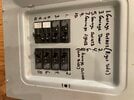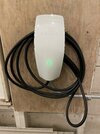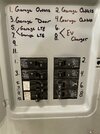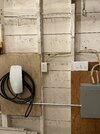My wife and I determined that for our particular needs we’d go ahead and order the wall connector. We have a family friend finishing his electrician journeyman work (he’s in the third year of apprenticeship), so we’re more than happy to give him hours.
Our home has 125amp service with a 60amp sub panel in the garage (we’re a little under 2,000 sq ft with all major energy hog appliances running on natural gas except the AC). With the current setup of our sub panel, and what’s used on the main, we can either install a 40amp or 50amp breaker for the wall charger.
Will the 40amp vs 50amp breaker make that much of a difference for day-to-day charging (assuming we probably aren’t draining more than 80 miles of a range on an average day)? I know the numbers Tesla claims but we’re interested in real-world experience. Our load calculations show we shouldn’t have issues with a 50amp given the only other breaker on the side of the garage subpanel we plan to use is the garage door opener (one car garage). But, our garage is unfinished (exposed studs) so we’re considering a 40amp to put less stress on the wiring during large temperature fluctuations.
Also does anyone have experience with (particularly NJ) declaring self installs? We can’t use our friend’s credentials because he’s still apprenticing, so I imagine as a “homeowner install” the inspector will apply more scrutiny. Anything I should be prepared to answer outside of basic questions (ie: we used 6 awg wire, this Is a 60 amp panel, car won’t draw more than “X” amps at x V per the programmed commissioning, etc)? I could also just ask our friend to come for the inspection and pose as me.
Thanks in advance!
Our home has 125amp service with a 60amp sub panel in the garage (we’re a little under 2,000 sq ft with all major energy hog appliances running on natural gas except the AC). With the current setup of our sub panel, and what’s used on the main, we can either install a 40amp or 50amp breaker for the wall charger.
Will the 40amp vs 50amp breaker make that much of a difference for day-to-day charging (assuming we probably aren’t draining more than 80 miles of a range on an average day)? I know the numbers Tesla claims but we’re interested in real-world experience. Our load calculations show we shouldn’t have issues with a 50amp given the only other breaker on the side of the garage subpanel we plan to use is the garage door opener (one car garage). But, our garage is unfinished (exposed studs) so we’re considering a 40amp to put less stress on the wiring during large temperature fluctuations.
Also does anyone have experience with (particularly NJ) declaring self installs? We can’t use our friend’s credentials because he’s still apprenticing, so I imagine as a “homeowner install” the inspector will apply more scrutiny. Anything I should be prepared to answer outside of basic questions (ie: we used 6 awg wire, this Is a 60 amp panel, car won’t draw more than “X” amps at x V per the programmed commissioning, etc)? I could also just ask our friend to come for the inspection and pose as me.
Thanks in advance!






